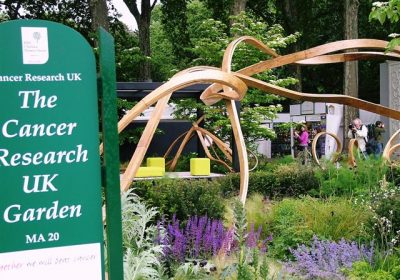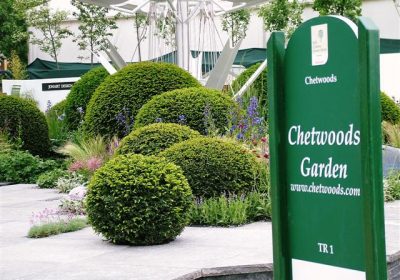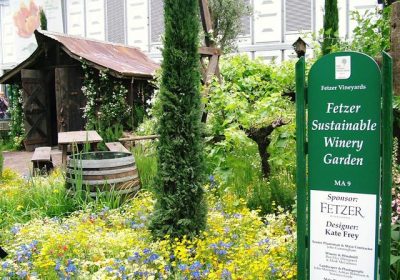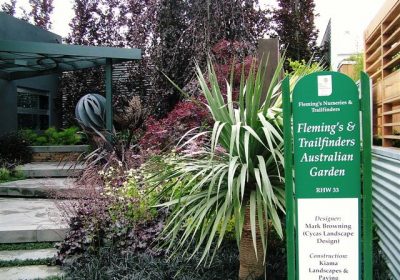Chic Garden Exhibitors Chelsea 2007
Description
These gardens incorporate new ideas, modern materials and planting for an urban environment, with imaginative and innovative design. Stylish and possibly controversial, these spaces will be striking and bold.
RHS Chelsea Flower Show
Small Gardens
RHS Chelsea Flower Show
Small Gardens
Alan Gardner Garden Design/Morningwood Landscapes Ltd
‘Perspectum’
Designer: Alan Gardner
Site number: RHW 44
Press Contact: Alan Gardner
Press Tel: 0121 313 0027
Contractor:
Exhibitor Address: 12 Swale Road, Sutton Coldfield, West Midlands. B76 2BH
Contemporary materials make up this multi-layered installation. Perspex walls become temporarily obscured by rain, frost or dew, so altering the viewer’s perception of the scheme. The Zen-like forms and meticulously finished structures of the garden are linked by a green velvet wave of turf. A single tree and a purple beech hedge add a naturalistic touch to the planting.
Designer Alan Gardner sees outside spaces as 3D canvases and believes his work would not look out of place at the Tate Modern. He has created 23 RHS show gardens over the last 10 years, pushing the boundaries of garden design, and considers himself a Landscape Artist. This is Alan’s first time at Chelsea, and with his blue spiky hair, yellow glamoflage trousers and brightly coloured nails this Brummie designer really is one of a kind.
Gardenmakers – Caroline De Lane Lea & Louise Cummins
‘The Suber Garden’
Designer: Louise Cummins and Caroline De Lane Lea
Site number: RHW 45
Sponsor: Conchango (uk) plc
Press Contact: Louise Cummins or Caroline De Lane Lea
Press Tel: Louise – 07759 916458 or Caroline – 07976 621156
Email: [email protected] or [email protected]
Contractor: Wayne Bonner Landscapes
Exhibitor Address: Gardenmakers, 27 Rivermount, Walton-on-Thames, Surrey. KT12 2PR or Gardenmakers, 24 Sutherland Street, London, SW1V 4LA
‘The Suber Garden’
Designer: Louise Cummins and Caroline De Lane Lea
Site number: RHW 45
Sponsor: Conchango (uk) plc
Press Contact: Louise Cummins or Caroline De Lane Lea
Press Tel: Louise – 07759 916458 or Caroline – 07976 621156
Email: [email protected] or [email protected]
Contractor: Wayne Bonner Landscapes
Exhibitor Address: Gardenmakers, 27 Rivermount, Walton-on-Thames, Surrey. KT12 2PR or Gardenmakers, 24 Sutherland Street, London, SW1V 4LA
‘The Suber Garden’ aims to highlight the threat to the natural habitats of the Cork Oak (Quercus suber).
Cork bottle stoppers account for almost 70% of the total value of the cork market. The increasing use of alternative wine stoppers is threatening the continued economic viability of Cork forests, a valuable habitat for the endangered Iberian Lynx, the Iberian Eagle and the Barbary Deer. Unless the commercial value of cork is maintained there is a risk that Mediterranean Cork Oak landscapes, which cover approx. 2.7 million hectares in Portugal, Spain, Algeria, Morocco, Italy, Tunisia and France, will face economic crisis and possible destruction.
Within ‘The Suber Garden’
Cork furniture, wall decorations and other elements in cork highlight the alternative uses for this material, which is versatile, sustainable and environmentally friendly. Harvested from the bark of the Cork Oak, without damaging the tree, the bark is left to re-grow naturally before the next harvest is made.
Cork furniture, wall decorations and other elements in cork highlight the alternative uses for this material, which is versatile, sustainable and environmentally friendly. Harvested from the bark of the Cork Oak, without damaging the tree, the bark is left to re-grow naturally before the next harvest is made.
At the centre of ‘The Suber Garden’ is a sloping, semi-circular wall of a burnt orange colour. The shape is inspired by the bark strips harvested from the Cork Oak, and the colour reflects that of the residual bark left after harvesting. A paved path of sandstone set in gravel winds past a Cork Oak tree, which stands at the entrance to the garden, and arrives at an intimate seating area. Grasses, thymes and drought tolerant planting surround the tree and blend into the path.
The planting is a relaxed and informal combination of grasses and perennials, with some additional key plants for structure structural planting. Again inspired by the vivid colours of the stripped Cork Oak, the plants are chosen from a palette of cinnamon and burgundy, with accents of purple, and calming shades of green to offset the other hot, dry colours.
‘The Suber Garden’ includes plants that are attractive to wildlife; including Allium, Knautia, Lavandula and Nandina.
Helios
‘Upstairs / Downstairs’
Designer: Kate Gould
Site number: RHW 48
Sponsor: Helios / The Green Room Consultancy
Press Contact: Kate Gould
Press Tel: 07989 558 804
Email: [email protected]
Contractor: The Green Room Consultancy
Exhibitor Address: 159 Valley Drive, Kingsbury, London. NW9 9NT
‘Upstairs / Downstairs’
Designer: Kate Gould
Site number: RHW 48
Sponsor: Helios / The Green Room Consultancy
Press Contact: Kate Gould
Press Tel: 07989 558 804
Email: [email protected]
Contractor: The Green Room Consultancy
Exhibitor Address: 159 Valley Drive, Kingsbury, London. NW9 9NT
This private basement garden is a ‘downstairs’ outside room designed for two people to share in the summer. ‘Upstairs / Downstairs’ is a garden for relaxing. Water provides soothing sounds, and a canopy of lush green foliage creates a private environment with interesting views and dappled light.
The garden is slightly retro with bold red colouring in the hard landscaping, which compliments the muted plant palette. Planting is’ jungly’ and bold and includes Dicksonia antarctica, Dryopteris erythrosora, Hosta ‘Frances Williams’, Acanthus mollis and Acer palmatum. The plants in this garden are suitable for shady areas and need minimum maintenance.
A ‘daybed’ offers somewhere to relax, or even sleep in at night. From the daybed a glass water feature can be partly seen through a thin screen of bamboo. The water feature looks like a window and is edged with stainless steel louvres.
Where possible, materials in this garden have been recycled or reclaimed and the wood is from environmentally sustainable sources.
This is the garden designer’s, Kate Gould, second time at Chelsea; in 2005 Kate was awarded a silver medal for a small garden in the City Garden category. Kate started Helios in 1998, after working in office jobs. The Green Room Consultancy, which is building ‘Upstairs / Downstairs’, is a new business that she set up with a partner this year.
New Hall, University of Cambridge
‘The Transit of Venus’
Designer: Sue Goss
Site number: RHW 47
Sponsor: New Hall, University of Cambridge
Press Contact: Juliet Banfield
Press Tel: 01223 762288
Email: [email protected]
Architect: AC Architects (Cambridge) Ltd
Exhibitor Address: New Hall, University of Cambridge, Huntingdon Road, Cambridge. CB3 0DF
‘The Transit of Venus’
Designer: Sue Goss
Site number: RHW 47
Sponsor: New Hall, University of Cambridge
Press Contact: Juliet Banfield
Press Tel: 01223 762288
Email: [email protected]
Architect: AC Architects (Cambridge) Ltd
Exhibitor Address: New Hall, University of Cambridge, Huntingdon Road, Cambridge. CB3 0DF
The shape, plants, colours and objects in ‘The Transit of Venus’ relate to the themes of astronomy, light and science. A curved polished concrete wall sweeps through like the path of Venus, and the Earth’s fragile atmosphere is symbolised by a glass globe filled with growing plants, which contrasts with a dry, cracked globe at the front of the garden.
The Transit of Venus is a rare event, occurring when Venus passes between the Sun and the Earth. It is important because it enabled astronomers to calculate the distance from the Earth to the Sun, and eventually the size of our Solar System. The mathematical key to the calculations was ‘parallax’; ‘the apparent difference in position of an object caused by a change of viewpoint’. This happens in all gardens, but in this garden visitors specifically see the mirrored reflection of a black disk, moving across a bright yellow background.
The garden has strong sculptural presence, reflecting New Hall’s modernist white architecture and art collection. Three vertical panels provide the central feature and are vehicles for reflections, silhouettes and shadows. Surrounding walls show off colourful planting.
Vibrantly coloured planting on the left follows the sequence of the colours of light seen through a prism; hot colours look nearby and fiery, like stars viewed through a radio telescope. The glass globe in the far right looks more distant and is held in a steel tripod, reminiscent of a science lab. Where the floor is visible, it is mulched thickly with crushed shells, traditionally associated with the Goddess Venus.
The main planting in the garden represents a prism, with the colours of the rainbow; graduating from red at the back, through orange, yellow, green, blue, indigo and finally to violet. There is liberal use of irises in reference to the Greek Goddess Iris. Other plants that tie into the garden’s theme include Venus’ Looking Glass’ (Legousia speculum-veneris) and the Honey Locust tree (Gleditsia triacanthos ‘Sunburst’).
To create interesting shadows and reflections on the mirrors, plants have been selected for their architectural and statuesque qualities; Allium schubertii, Fritillaria persica “Adiyaman” and Verbascum “Gainsborough”. Plants selections for “The Transit of Venus” link this garden to those at New Hall, where selections such as Eremurus and Oriental poppies are also found. Most of the plants in this garden are drought tolerant and sun loving.
This is the garden designer Sue Goss’ fifth time at the RHS Chelsea Flower Show; her previous designs, undertaken with New Hall students doing their final project of a two year course, were all small gardens.
The Children’s Society
‘Lust for Life’ by the Children’s Society
Designer: Angus Thompson
Site number: RHW 46
Sponsor: Ecclesiastical Insurance
Press Contact: David Hudi Dinnage
Press Tel: 0207 841 4419
Email: [email protected]
Contractor: Mark Gregory, Landform
Exhibitor Address: The Children’s Society, Edward Rudolf House, Margery Street, London, WC1X 0JL
‘Lust for Life’ by the Children’s Society
Designer: Angus Thompson
Site number: RHW 46
Sponsor: Ecclesiastical Insurance
Press Contact: David Hudi Dinnage
Press Tel: 0207 841 4419
Email: [email protected]
Contractor: Mark Gregory, Landform
Exhibitor Address: The Children’s Society, Edward Rudolf House, Margery Street, London, WC1X 0JL
The Children’s Society Garden takes inspiration from the song ‘Lust for Life’ by Iggy Pop and is an optimistic and invigorating space.
Vibrantly coloured planting and ‘thought bubbles’, inspired by Roald Dahl’s ‘BFG’ represent the dreams of children and their manifestation into reality. An arc of water, symbolizing the power and triumph of the human spirit, traverses the garden in rhythmic bursts to the beat of ‘Lust For Life’.
The 3D planted ‘bubbles’ rise and burst free from the square planting bed, which includes both salvias and alliums. Clusters of Allium echo the main ‘dream bubble’ shape and imply other dreams not pursued to fruition. An odd prickly Eryngium provides contrast and subversively suggests darker thoughts. A fruiting Mespilus tree signifies dreams being fully realized.
‘Lust for Life’ by the Children’s Society also includes eryngiums (to encourage birds), and salvias (to encourage bees).
The garden is for urban office workers to rest in and rejuvenate during their breaks. The combination of clean cut spaces, pure use of materials, and invigorating character of the water and colour scheme aims to create gentle cross-sensory stimulation for weary office staff.
Designer Angus Thompson, a newcomer to the RHS Chelsea Flower Show, designed this urban garden to reflect children’s zest and energy for life and the innate potential of childhood. Angus studied at the Inchbald School of Design and won the ‘Principal’s Award’ in 2004.
UCF Students
Designer: Richard Sneesby
Site number: RHW 43
Press Contact: Richard Sneesby
Press Tel: 01326 370400
Email: [email protected]
Contractor:
Exhibitor Address: University College Falmouth, Tremough, Penryn, Cornwall. TR10 9EZ
Designer: Richard Sneesby
Site number: RHW 43
Press Contact: Richard Sneesby
Press Tel: 01326 370400
Email: [email protected]
Contractor:
Exhibitor Address: University College Falmouth, Tremough, Penryn, Cornwall. TR10 9EZ




